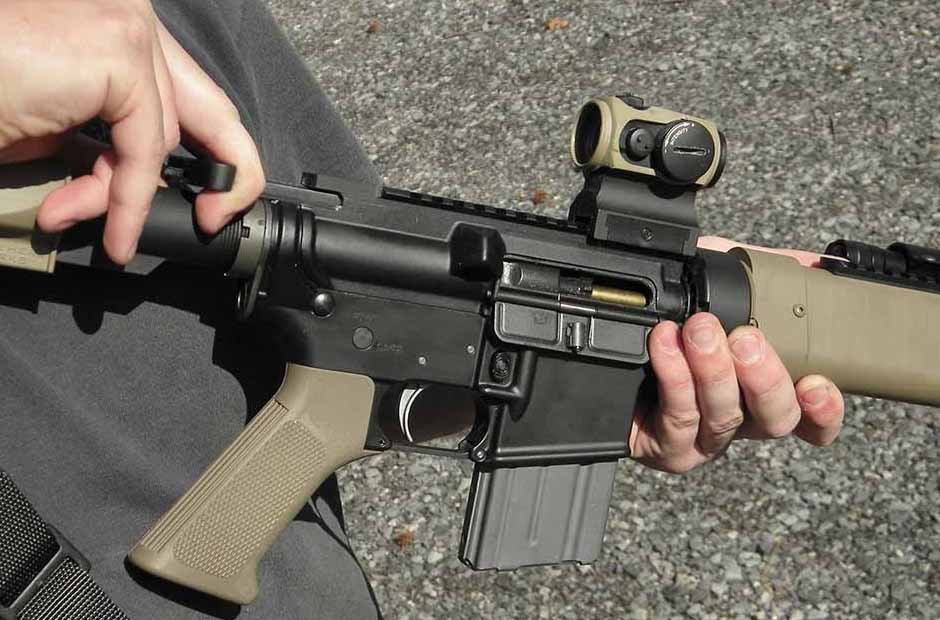The charging handle is a crucial component on many firearms, particularly rifles and carbines. Although it may appear simple in design, the charging handle plays a vital role in the operation and functionality of the firearm. We will explore the purpose of a charging handle on a gun, its functions, and its significance in the shooting process.
Table of Contents
Purpose of a charging handle
1. Loading and Chambering:
One of the primary purposes of a charging handle is to facilitate the loading and chambering of rounds into the firearm. When the charging handle is pulled back, it retracts the bolt carrier group (BCG), creating an open space in the chamber area. This also permits inserting a fresh magazine or individual rounds into the firearm’s magazine. The spring-loaded BCG pushes forward by releasing the charging handle, selecting a round from the magazine, and chambering it into the firing position.
2. Clearing Malfunctions
Another critical function of the charging handle is to help clear malfunctions that may occur during shooting. In the circumstance of a misfire, failure to eject, or other malfunctions, the charging handle delivers a manual way to manually manipulate the firearm’s action. By pulling back and releasing the charging handle, the shooter can manually extract and expel the malfunctioning round, permitting the chambering of a fresh round and continued shooting.
3. Verifying Chamber Status:
The charging handle is a visual and tactile indicator of the firearm’s chamber status. By pulling back the charging handle, the shooter can visually inspect the chamber to ensure it is empty or loaded. This is particularly important during firearm safety checks, magazine changes, or transitioning between shooting and non-shooting scenarios. The ability to visually verify the chamber status provides an additional layer of safety and control for the shooter.
4. Enhanced Weapon Control:
The charging handle also enhances weapon control and manipulation. Its extended length and textured surface permit a secure grip and easy operation, even while wearing gloves or in high-stress situations. This facilitates quick and efficient manipulation of the firearm’s action, promoting faster reloads, malfunction clearing, and overall weapon control.
5. Ambidextrous Operation:
Many modern firearms are designed with ambidextrous charging handles, allowing right-handed and left-handed shooters to operate easily. Ambidextrous charging handles provide versatility and adaptability in various shooting scenarios, enabling shooters to effectively manipulate the firearm’s action regardless of their dominant hand. This feature is specifically beneficial for shooters with specific needs or preferences, as it ensures the relaxed and efficient operation of the firearm.
6. Modular Upgrades and Customization:
The charging handle on a firearm is often a modular component that can be upgraded or customized to suit the shooter’s preferences. Different designs, sizes, and latch options allow shooters to choose a charging handle that best aligns with their shooting style and needs. Upgraded charging handles may feature ambidextrous controls, extended latch options, or enhanced ergonomics for improved weapon manipulation and control.
7. Platform Compatibility:
Charging handles are specific to firearm platforms, such as AR-15 rifles or AK-47 variants. Diverse firearm platforms may have variations in charging handle design and operation. Shooters must ensure compatibility between the charging handle and their explicit firearm. This ensures proper functioning, reliable operation, and a secure fit within the firearm’s receiver.
8. Training and Familiarity:
The use of a charging handle on a firearm is a fundamental aspect of training and familiarity for shooters. Understanding the purpose, operation, and proper manipulation of the charging handle is essential for safe and effective firearm handling. Training drills often incorporate charging handle manipulation to simulate real-world scenarios, enhance weapon control skills, and boost muscle memory for quick and efficient operation.
9. Different Types of Charging Handles:
There are various types of charging handles available for different firearm platforms. Traditional charging handles are typically located on the rear upper receiver of the firearm, while some modern designs feature side-charging handles or reciprocating charging handles. Each type offers its own advantages and considerations in terms of ergonomics, ease of operation, and compatibility with accessories or optics.
10. Maintenance and Care:
Proper maintenance and care of the charging handle are paramount to ensure its dependable operation and longevity. Regular cleaning, lubrication, and inspection are necessary to yank dirt, debris, or fouling that can hinder the charging handle’s smooth operation. Furthermore, shooters should observe the manufacturer’s guidelines for maintenance and periodically inspect for any signs of wear or damage that may affect the charging handle’s functionality.
The charging handle on a firearm serves multiple important purposes in the operation and functionality of the weapon. From loading and chambering rounds to clearing malfunctions, verifying chamber status, enhancing weapon control, and allowing for ambidextrous operation, the charging handle is a critical component for shooters. Its modular nature also provides opportunities for customization and upgrades, enabling shooters to choose a charging handle that suits their preferences and shooting style. Understanding the purpose and proper manipulation of the charging handle is essential for safe and effective firearm handling. Whether for self-defense, sport shooting, or professional use, the charging handle plays a significant role in the shooter’s ability to control and operate the firearm. If you are looking for Charging handles, check 3DGunman LLC.










